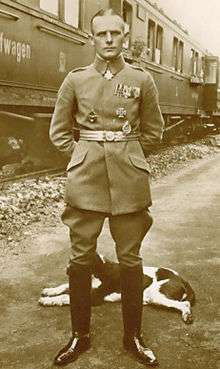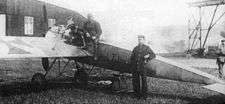Otto Parschau
| Otto Parschau | |
|---|---|
 Photo of Leutnant Otto Parschau just after earning the Pour le Mérite | |
| Born |
11 November 1890 Klutznick, Allenstein, East Prussia |
| Died |
21 July 1916 (aged 25) Grévillers, France |
| Allegiance |
|
| Service/branch | Luftstreitkräfte |
| Years of service | 1910-1916 |
| Rank | Leutnant |
| Unit | FFA 42, FFA 261, FFA 32 |
| Commands held | Abwehrkommando Nord |
| Awards | Pour le Mérite, Royal House Order of Hohenzollern, Iron Cross 2nd Class |
Leutnant Otto Parschau (11 November 1890 – 21 July 1916) was a German World War I Flying Ace and recipient of the Pour le Mérite, Royal House Order of Hohenzollern, and Iron Cross, First Class. He was noted as one of the pre-eminent aces on the Fokker Eindecker. He was one of the world's first flying aces, as along with Leutnant Kurt Wintgens, Parschau was one of the original pilots entrusted with the prototype of the revolutionary Fokker Eindecker fighter plane with a machine gun synchronized to fire safely through its propeller arc via use of a gun synchronizer.[1]
Background
Parschau was born in Klutznick, in the Allenstein district of East Prussia. He became a commissioned officer a year after having joined the Infanterie-Regiment Nr. 151 in 1910. Parschau was trained as a pilot in Johannisthal, Darmstadt and in Hanover and received his licence on 4 July 1913.[2]
World War I
Upon the outbreak of hostilities in August 1914 Parschau was already serving with the Luftstreitkräfte, and soon found himself flying two-seaters in operations on the Champagne front and then in Flanders and Alsace-Lorraine before being posted to West Prussia and Galicia, on the Eastern Front.[2]
The Green Machine (A.16/15)

Parschau was assigned a Fokker A.III aircraft bearing the IdFlieg military serial number of A.16/15, previously used by one Oberleutnant Waldemar von Buttlar. This unarmed monoplane had been privately purchased in 1913 by von Buttlar,[3] whose aircraft had been requisitioned by the Fliegertruppe along with his commissioning as an officer in the Deutsches Heer at the outbreak of hostilities, and had been painted a shade of green, the colour of von Buttlar's previous Marburg-based Jäger Regiment 11.[4] Parschau had served[5] with the same, surreptitiously named Brieftauben-Abteilung Ostende unit, abbreviated as BAO in German military communications of the time, in Belgium as Oberleutnant von Buttlar did in November 1914, where the two German officers could have first made contact. As A.16/15 still bore the green color of von Buttlar's old unit, the aircraft became distinctive as Parschau's 'Green Machine', right from the outbreak of World War I. Parschau flew this machine on a roving commission for nearly a year,[5] serving with FFAs 22 and 42 and the aforementioned "BAO" unit, which was actually a group of four FFA units operating as one for the Oberste Heeresleitung or OHL, the World War I German Army's High Command office. In this period, Parschau flew his distinctive machine on the Champagne front during October and November 1914. Following this were periods in Flanders and Alsace-Lorraine before Parschau was posted first to West Prussia and then on to Galicia on the Eastern Front. His travels were marked on the Fokker's fuselage.[2] This same aircraft would be the very first airframe ever to be fitted with a workable synchronization gear, and was equipped with the Fokker Stangensteuerung synchronizer — along with one Parabellum MG14 machine gun for its armament — in late May 1915 for Parschau's use and combat evaluation, and to function as the prototype Fokker Eindecker.

Later war service
Because Parschau was recognised as an experienced and proficient pilot, he was selected to go to FFA 62 at Douai as an instructor on monoplanes. Amongst his students at FFA 62 were the notable pioneer German flying aces, Max Immelmann and Oswald Boelcke.[2] Despite his earlier complaints of his Parabellum machine gun jamming, he managed to reel off a string of six victories over enemy airplanes between 11 October 1915[6] and 2 July 1916 as part of the Fokker Scourge. On 3 July 1916, he shot down an enemy observation balloon. In July 1916 he transferred to FFA 32, gaining his 8th victory on 9 July 1916.[7] He was awarded the Pour le Merite the following day.[8] On the 14th, AKN was severed from FFA 32 and Parschau was appointed to its command.[9]
On 21 July 1916 Parschau was mortally wounded during combat with the Royal Flying Corps over Grévillers.[7] He was severely wounded in the chest and also suffered a glancing bullet wound to the head, possibly from rounds fired by John Oliver Andrews. He retained enough control to land his plane behind German lines, and was rushed to a field hospital but died on the operating table.[10]
Notes
- ↑ Early German Aces of World War I. pp. 4, 9.
- 1 2 3 4 Early German Aces of World War I. p. 9.
- ↑ Scott, Josef (2012). Fokker Eindecker Compendium, Volume 1. Berkhampstead, Hertfordshire UK: Albatros Publications, Ltd. p. 32. ISBN 978-1-906798-22-2.
- ↑ vanWyngarden 2006, p. 9.
- 1 2 vanWyngarden, Greg (2006). Osprey Aircraft of the Aces #73: Early German Aces of World War 1. Botley, Oxford UK & New York City, USA: Osprey Publishing. p. 9. ISBN 978-1-84176-997-4.
- ↑ The Aerodrome Forum
- 1 2 Above the Lines: The Aces and Fighter Units of the German Air Service, Naval Air Service and Flanders Marine Corps 1914 - 1918. p. 138.
- ↑ http://www.pourlemerite.org/ Retrieved on 26 April 2010.
- ↑ Early German Aces of World War I. p. 64.
- ↑ Early German Aces of World War I. p. 66.
References
- van Wyngarden, G. Early German Aces of World War 1. Oxford: Osprey Publishing, 2006. ISBN 1-84176-997-5.
- Grosz, Peter M., Windsock Datafile No. 91, Fokker E.I/II, Albatros Publications, Ltd. 2002. ISBN No. 1-902207-46-7.
- Franks, Norman L. R., et al., Above the Lines: The Aces and Fighter Units of the German Air Service, Naval Air Service and Flanders Marine Corps 1914 - 1918 Grub Street, 1993. ISBN 0-948817-73-9, ISBN 978-0-948817-73-1.